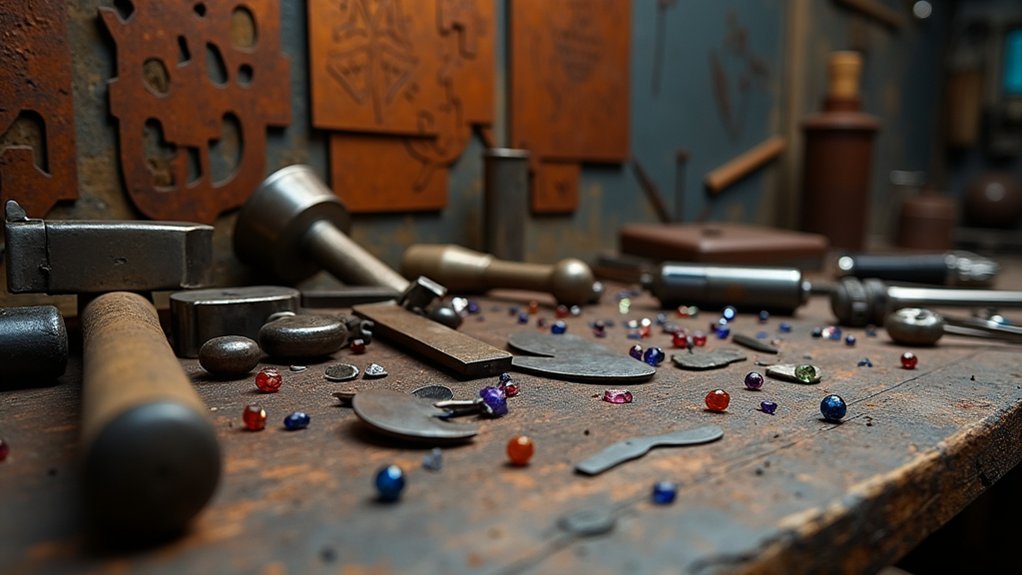To become a metalsmith apprentice, you’ll need a high school diploma or GED and should develop strong math and chemistry skills. Start by researching local metalsmithing shops and organizations, then prepare a compelling resume highlighting any relevant experience. Network at workshops, trade shows, and exhibitions while joining professional organizations like the Society of North American Goldsmiths. Apply to multiple programs and follow up with potential mentors to increase your chances of securing hands-on training opportunities that’ll shape your metalworking career.
What Is a Metalsmith Apprenticeship

A metalsmith apprenticeship offers hands-on training under an experienced craftsperson’s guidance, where you’ll learn to manipulate and shape various metals into functional or artistic pieces. This vocational training combines practical workshop experience with essential theoretical knowledge about metallurgy, tool usage, and design principles.
You’ll master fundamental skills like forging, welding, soldering, and finishing techniques that guarantee high-quality metalwork. Your projects will span diverse areas, from jewelry making to creating furniture and decorative art, building a thorough skill set.
The apprenticeship emphasizes safety practices and equipment maintenance, creating a secure working environment. You’ll gain both technical expertise and artistic vision, preparing you for professional metalsmithing careers through structured, mentorship-based learning.
Educational Requirements and Prerequisites
Foundation building starts with obtaining your high school diploma or GED, which serves as the minimum educational requirement for most metalsmith apprenticeships. You’ll benefit from strong math and chemistry skills during your training.
Many programs prefer candidates with postsecondary education in metalsmithing or jewelry design. Community and technical colleges offer associate degrees that’ll enhance your qualifications and provide foundational knowledge.
| Education Level | Program Type | Benefits |
|---|---|---|
| High School | Diploma/GED | Minimum requirement |
| Community College | Associate Degree | Enhanced qualifications |
| Technical School | Certificate Program | Specialized skills |
| Retail Experience | Jewelry Sales | Industry familiarity |
| Networking | Professional Connections | Apprenticeship opportunities |
Consider gaining retail experience in jewelry sales to familiarize yourself with metals and customer service. Networking with experienced metalsmiths can provide insights and lead to jewelry apprentice positions.
Finding and Applying to Apprenticeship Programs

Once you’ve built your educational foundation, you’ll need to actively search for apprenticeship opportunities in the metalsmithing field.
Start by researching local metalsmithing shops, studios, and organizations that offer apprenticeship programs tailored to your interests. Prepare a compelling resume and cover letter highlighting relevant experience, like jewelry sales or design courses.
Network strategically by attending workshops, trade shows, and exhibitions where you’ll meet professional jewelers and industry veterans. These connections often provide insider knowledge about available opportunities.
Consider joining the Society of North American Goldsmiths (SNAG) for additional resources and apprenticeship listings.
Don’t limit yourself to one application. Apply to multiple apprenticeship programs and follow up with potential mentors to demonstrate your genuine enthusiasm and commitment to mastering the craft.
Types of Metalsmith Apprenticeships Available
Variety defines the metalsmith apprenticeship landscape, with programs spanning one to five years depending on your chosen specialization and skill complexity.
You’ll find metalsmith apprenticeships in several distinct areas, each offering unique career paths.
Jewelry making apprenticeships train you in designing and crafting precious metal accessories, often leading to bench jeweler positions where you’ll repair and create intricate pieces.
Silversmithing programs focus on creating decorative and functional silver items, from tableware to artistic sculptures.
Blacksmithing apprenticeships teach traditional forge techniques for creating iron and steel objects.
Traditional workshop-based programs offer hands-on mentorship under experienced craftspeople, while Trailblazer apprenticeships emphasize vocational qualifications through employer partnerships.
Organizations like the Goldsmiths’ Company provide structured schemes combining practical training with classroom education, ensuring thorough skill development.
Skills Development and Training Components

Metalsmith apprenticeships build your expertise through carefully structured training components that transform raw talent into professional craftsmanship. Your skills development encompasses technical mastery, creative expression, and business acumen essential for a sustainable creative career.
The extensive training components include:
- Technical Foundation – You’ll master working with various metals, understanding their unique properties, and operating specialized equipment like torches, anvils, and hammers for fabrication and finishing processes.
- Design Conceptualization – You’ll develop artistic vision through design courses that enable you to conceptualize and execute creative projects while strengthening technical abilities.
- Business Knowledge – You’ll learn pricing strategies, customer service, and marketing techniques necessary for selling your metalwork creations professionally.
Continuous learning through workshops, mentorship, and short courses keeps you current with industry trends and advances your craftsmanship.
Career Advancement After Completing Your Apprenticeship
When you complete your metalsmith apprenticeship, diverse career paths open up that can greatly expand your professional opportunities and earning potential. You can pursue positions as a bench jeweler, jewelry designer, or store manager, each offering increased responsibility and compensation.
Many apprentices shift into specialized roles like antique restoration or custom jewelry creation, enhancing marketability while allowing creative expression.
With experience, you’ll advance to supervisory or teaching positions, sharing expertise with future artisans. Continued education through workshops and advanced courses opens niche opportunities in gemology or horology.
Networking within the jewelry industry proves essential for accessing collaborations, exhibitions, and higher-profile projects that greatly boost your career trajectory and professional reputation.
Frequently Asked Questions
How to Become a Jeweler Apprentice?
You’ll need a high school diploma and strong math skills. Gain retail jewelry experience, network with professional jewelers, and send tailored applications. Apprenticeships provide hands-on training in stone setting and repair techniques.
What Is the Highest Paid Apprenticeship Job?
You’ll find electrical engineering apprenticeships offer the highest pay, earning upwards of $60,000 annually. Construction roles like pipefitters and electricians also provide excellent compensation, typically ranging from $50,000 to $70,000 per year.
How Do You Become a Metalsmith?
You’ll need a high school diploma, then gain hands-on experience through retail work with metals. Enroll in vocational courses, network with experienced artisans, and apply for apprenticeships at local studios.
How to Become a Blacksmith Apprentice?
You’ll need a high school diploma, then gain experience through workshops or community college courses. Network with professional blacksmiths and join organizations to find apprenticeship opportunities requiring 2-4 years of training.
In Summary
You’ll find that becoming a metalsmith apprentice opens doors to a rewarding hands-on career. You’ve learned about educational requirements, how to find programs, and the various specializations available. You’ll develop essential skills through structured training and mentorship. Once you’ve completed your apprenticeship, you’ll have multiple advancement opportunities, from starting your own business to specializing in high-end metalwork. You’re now equipped with the knowledge needed to begin your metalsmithing journey.





Leave a Reply